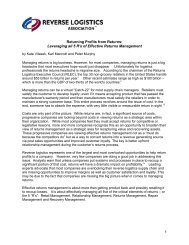PROCESS ASSESSMENT IN THE SUPPLY CHAIN: the eMBARQtM ...
PROCESS ASSESSMENT IN THE SUPPLY CHAIN: the eMBARQtM ...
PROCESS ASSESSMENT IN THE SUPPLY CHAIN: the eMBARQtM ...
You also want an ePaper? Increase the reach of your titles
YUMPU automatically turns print PDFs into web optimized ePapers that Google loves.
also identify <strong>the</strong> areas in which current performance levels<br />
are satisfactory, and those in which increased efforts will not<br />
bring competitive advantage.<br />
Remember to determine <strong>the</strong> required level of process performance<br />
for each subcategory identified for improvement (see<br />
<strong>the</strong> diagram in Figure 2, taken from <strong>the</strong> Standards, for an<br />
explanation of <strong>the</strong>se terms). Should it approach or be at bestpractice<br />
level in order to achieve company goals? Is something<br />
between minimum standard and best practice good enough?<br />
Specifically, determine which elements of <strong>the</strong> descriptions of<br />
best practice are required. Wherever possible, quantify <strong>the</strong><br />
cost (direct and indirect) of <strong>the</strong> process as it currently exists,<br />
and <strong>the</strong>n estimate <strong>the</strong> potential cost savings that would result<br />
from improved performance. Priorities should focus on <strong>the</strong><br />
areas that will have <strong>the</strong> most positive impact on customers,<br />
<strong>the</strong> areas that will deliver <strong>the</strong> most benefit for resources and<br />
time invested, and/or where poor performance will generate<br />
<strong>the</strong> most risk if not addressed quickly. Based on <strong>the</strong>se assessment<br />
results, <strong>the</strong> team should <strong>the</strong>n propose action plans,<br />
resource requirements, financial impact, and key performance<br />
metrics to measure <strong>the</strong> success of <strong>the</strong> changes. The final presentation<br />
to management should include all of <strong>the</strong>se areas.<br />
A Matter of Perspective<br />
During <strong>the</strong> 2007 assessment, an interview was conducted with<br />
a customer service representative (CSR). During <strong>the</strong> interview,<br />
a call came in from a customer requesting delivery status on<br />
three different orders. The CSR did a very nice job of engaging<br />
in conversation with <strong>the</strong> customer while accessing different<br />
applications, cutting and pasting fields from one application to<br />
ano<strong>the</strong>r, and jumping from screen to screen to ascertain <strong>the</strong> current<br />
status. Within a period of four to six minutes, <strong>the</strong> CSR had<br />
provided <strong>the</strong> status for all three jobs, and completed <strong>the</strong> call<br />
with a happy customer since everything was on schedule.<br />
The number of screens accessed exceeded five for each order.<br />
At <strong>the</strong> end of <strong>the</strong> interview, <strong>the</strong> CSR was asked what <strong>the</strong> company<br />
should change to make <strong>the</strong> process better—<strong>the</strong>re was<br />
no response. In this person’s view, everything worked as it was<br />
intended to work. The multiple screens were part of <strong>the</strong> training<br />
received to do <strong>the</strong> job. When <strong>the</strong> lead workers are unaware<br />
that <strong>the</strong>re is a “better way,” <strong>the</strong>y are not in a position to identify<br />
improvement opportunities. It is up to <strong>the</strong> interviewer, working<br />
with <strong>the</strong> Standards, to understand <strong>the</strong> shortcomings and highlight<br />
<strong>the</strong>m for possible improvement.<br />
As an update, <strong>the</strong> applications <strong>the</strong> CSR accessed to gain <strong>the</strong><br />
status report information are now on a high priority list for<br />
replacement.<br />
Figure 2: Process Performance Diagram from cscMP’s Supply Chain Management Process Standards<br />
4.0 deliver<br />
4.1 order MAnAgeMent<br />
4.1.1 order<br />
receipt and<br />
entry<br />
ProceSS<br />
AttriBute<br />
MAin ProceSS Section<br />
ProceSS SuBcAtegory<br />
SuggeSted MiniMuM<br />
ProceSS StAndArd<br />
• Capability to receive and process customer<br />
orders by phone, fax, e-mail, and EDI<br />
• Orders entered into single database for all<br />
operators at a given region (Europe, Asia<br />
Pacific, etc.)<br />
• CSRs have language skills required to support<br />
selling geographies<br />
• Price lists updated regularly for manual price<br />
confirmation<br />
• Web-based order entry for select trading<br />
partners<br />
• Export orders check for denied parties<br />
• KPI: 98% data accuracy at order level<br />
deScriPtionS of SuggeSted<br />
MiniMuM StAndArd for <strong>the</strong><br />
ProceSS AttriBute<br />
tyPicAl BeSt-<br />
PrActice ProceSS<br />
• Product priced accurately at time of order entry,<br />
including adjustments for configurations<br />
• Use of EDI and/or web-enabled order management<br />
to allow remote order entry, configuration<br />
management, order status updates, etc.<br />
• Online order entry systems have multi-language<br />
and currency capabilities<br />
• Linkage to POS systems in <strong>the</strong> case of retailers to<br />
create releases as target inventory levels are met<br />
• Outbound transportation options and pricing<br />
included at order entry<br />
• Automated cross-sell/up-sell capability<br />
• KPI: >99.5% data accuracy at order level<br />
deScriPtionS of tyPicAl<br />
BeSt PrActiceS for <strong>the</strong><br />
ProceSS AttriBute<br />
7




